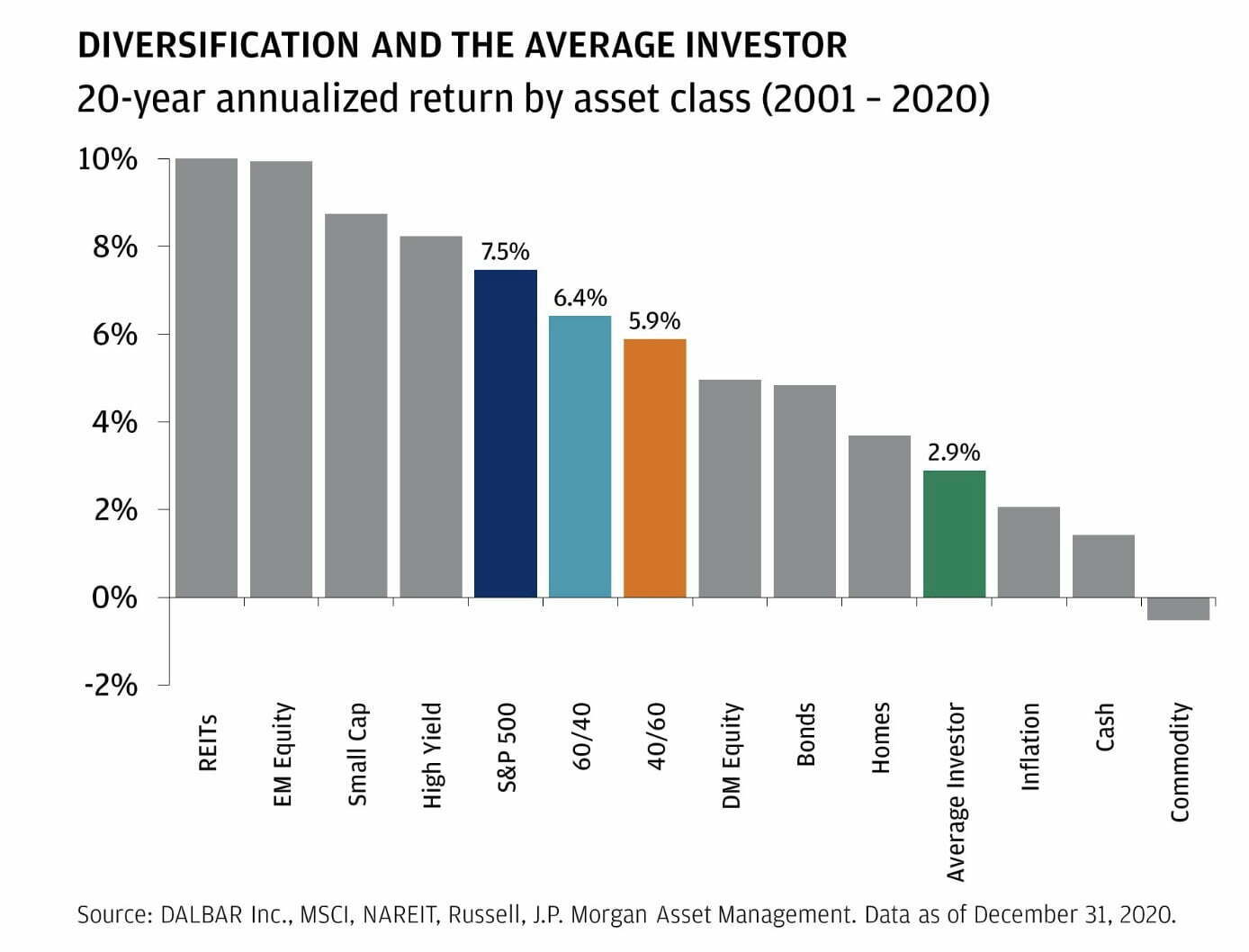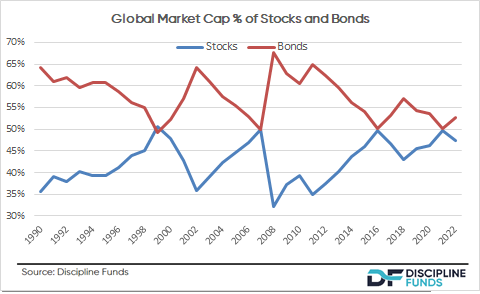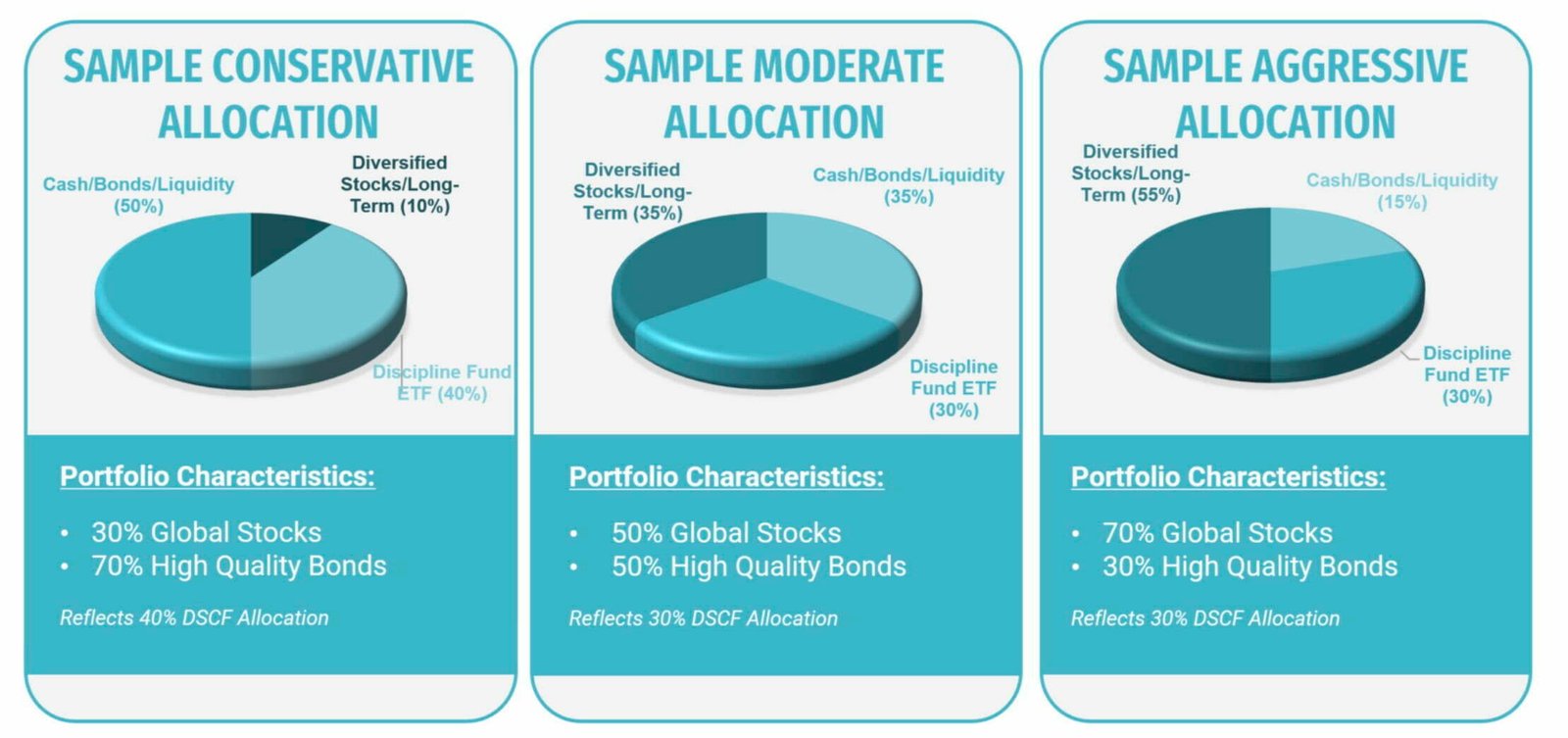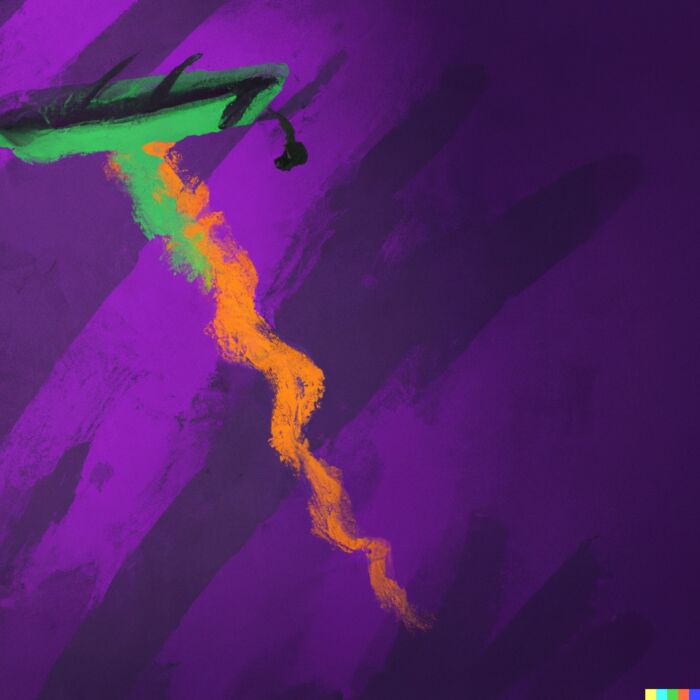What unites investors of all backgrounds and levels of experience are the challenges and curveballs markets throw at them on a consistent basis.
Staying the course with any given strategy is not easy.
It requires extreme levels of patience and especially “discipline” to pull it off.
We’re not expected to wait years before seeing results in the gym but we need to have the discipline to stick with funds and strategies when they inevitably underperform for extended periods of time.
Diversification and the Average Investor: 2001 – 2020

By examining research presented by JP Morgan, it’s fascinating to see that the average investor underperforms a 100% bond asset allocation strategy.
Behavioural errors and lack of discipline are the primary culprits as the average investor will often bail or tinker with a sensible investing plan when they ought to be disciplined.
With this in mind, we’re thrilled to welcome back Cullen Roche to our new interview series “The Strategy Behind The Fund” to discuss DSCF ETF – The Discipline Fund.
I’ve gotten to know Cullen online in recent months, as I started Picture Perfect Portfolios around the same time he launched his YouTube channel @ThreeMinuteMacro.
It’s fantastic to see what he’s been able to do with his channel in such a short period of time!
Getting back on track, his fund is designed to help investors stay disciplined and committed to a sensible long-term investment strategy.
As a globally diversified asset allocation fund of funds, it features a unique “countercyclical rebalancing style” which we’ll examine in earnest.
But enough rambling from me; let’s turn things over to Cullen!

Review Of The Strategy Behind DSCF ETF (The Discipline Fund) with its creator Cullen Roche

Hey guys! Here is the part where I mention I’m a travel content creator! This “The Strategy Behind The Fund” interview is entirely for entertainment purposes only. There could be considerable errors in the data I gathered. This is not financial advice. Do your own due diligence and research. Consult with a financial advisor.

These asset allocation ideas and model portfolios presented herein are purely for entertainment purposes only. This is NOT investment advice. These models are hypothetical and are intended to provide general information about potential ways to organize a portfolio based on theoretical scenarios and assumptions. They do not take into account the investment objectives, financial situation/goals, risk tolerance and/or specific needs of any particular individual.
What’s The Strategy Of DSCF ETF?
For those who aren’t necessarily familiar with a “countercyclical rebalancing style” of asset allocation, let’s first define what it is and then explain this strategy in practice by giving some clear examples.

Traditional multi-asset index funds like the 60/40 portfolio rebalance back to fixed weightings at all times.
But the interesting thing about the actual markets is that the relative market cap of stocks vs bonds is quite dynamic.
Which means that a truly “passive” portfolio should rebalance in a dynamic manner.
Below is a chart showing the actual relative market caps of stocks vs bonds.

The problem with rebalancing back to a fixed weight like 60/40 is that it leaves you overexposed to stocks at the worst possible times (when the stock market cap booms).
This doesn’t make any sense!
Not only is it behaviorally inefficient, but it’s not actually passive because it deviates substantially from the actual market weights.
Our initial idea was to track the actual market caps and create a true “passive” ETF.
But we found that tracking the actual passive market caps leaves you with the same problem, and in fact, investors who track the passive market caps actually generate WORSE risk adjusted returns than an investor who INVERTS the weights.
We also found that this creates greater parity over time (more parity between the volatility contributions) and can thereby help investors construct a more behaviorally robust core holding in their asset allocations.
This isn’t a new idea, however.
John Bogle actually said that this is what he did in his personal portfolio to better control his own behavior.
All we did was take the same concept and wrap it into an automated algorithm to take our own behavioral biases out of the equation.

The Unique Features Of The Disciplined Fund DSCF ETF
Let’s go over all the unique features your fund offers so investors can better understand it.
What key exposure does it offer?
Is it static or dynamic in nature?
Is it active or passive?
Is it leveraged or not?
Is it a rules-based strategy or does it involve some discretionary inputs?
How about its fee structure?
The fund is structured as a fund of funds with global stocks and US bonds operating on a systematic algorithm.
It’s dynamic by design because, as we mentioned before, the actual market caps are dynamic.
A static approach makes no sense from a “passive” investing approach because the underlying market caps aren’t static.
There are several advantages to this structure.
First, the fund of funds structure uses a single ETF to create very tax efficient rebalancing.
The secret sauce of an ETF is that it can reduce or even avoid capital gains over time because it redeems shares inside the single ETF, whereas, if you held the underlying ETFs in single funds you’d have to rebalance each fund along the way thereby incurring capital gains as you sell your winners to rebalance.
We can rebalance INSIDE the single ETF and reduce or eliminate capital gains over time.
The other big advantage of the structure is that we’re one of the only ETFs that uses the actual Bogle approach.
So we’re helping reduce volatility at times when investors might be more prone to chase performance or panic sell.

What Sets DSCF ETF Apart From Other Asset Allocation Funds?
How does your fund set itself apart from other asset allocation funds being offered in what is already a crowded marketplace?
What makes it unique?
No one else is running this sort of systematic countercyclical approach.
Not even Vanguard!
I always found it strange that Bogle explicitly endorsed this strategy and the very company he founded never constructed a strategy like this.
There are lots of other static funds that do something similar, but none of them will actually rebalance over time in the same manner that our fund does.
They’re almost all static index funds rebalancing back to fixed weights.

What Else Was Considered For DSCF ETF?
What’s something that you carefully considered adding to your fund that ultimately didn’t make it past the chopping board?
What made you decide not to include it?
Great question.
I really wanted to create a sort of “all in one” fund that might be more of a true “all weather” approach.
That might include gold, managed futures and other more dynamic strategies.
But I ultimately decided it was more useful to build a core fund that was just stocks and bonds.
In my opinion it’s more efficient to hold those other sorts of positions outside of a single ETF so you can compartmentalize the positions in a more customized manner.

When Will DSCF ETF Perform At Its Best/Worst?
Let’s explore when your fund/strategy has performed at its best and worst historically or theoretically in backtests.
What types of market conditions or other scenarios are most favourable for this particular strategy?
On the other hand, when can investors expect this strategy to potentially struggle?
The fund is designed to be a relatively “passive” core holding.
It’s not designed to “beat the market”.
But the goal of the fund is to smooth returns over time and help investors construct a core tax efficient stock/bond holding that they can remain more comfortable with over time.
Since it’s stocks and bonds it will tend to underperform stocks in big bull markets and outperform in big bear markets.
But the goal overall isn’t to beat the stock market.
It’s to provide people with a smoother ride along the way and do so in a very tax efficient and behaviorally tolerable manner.

Why Should Investors Consider The Discipled Fund DSCF ETF?
If we’re assuming that an industry standard portfolio for most investors is one aligned towards low cost beta exposure to global equities and bonds, why should investors consider your fund/strategy?
It should have a lower standard deviation over time when compared to traditional stock/bond funds and it could do it in a more tax efficient manner in many cases.
But the real differentiator is that this is the only fund implementing the strategy that John Bogle, the father of passive investing, actually implemented.


How Does DSCF ETF Fit Into A Portfolio At Large?
Let’s examine how your fund/strategy integrates into a portfolio at large.
Is it meant to be a total portfolio solution, core holding or satellite diversifier?
What are some best case usage scenarios ranging from high to low conviction allocations?
The fund is really designed as a very efficient core holding.
I like to think of it as a 10 year holding so you can construct longer duration and shorter duration instruments around it in a core and satellite approach.
One of the cool aspects of the countercyclical approach is that it inverts a traditional core and satellite strategy.
So, for instance, in a traditional core/satellite strategy your stock satellite will grow out of balance with your core and you’ll always have to rebalance that satellite back to your target weight.
But DSCF inverts the rebalancing internally which means that as your stock satellite grows DSCF’s stock component is likely shrinking so you offset some of the growth and the need to rebalance the satellite.
And vice versa.
But because a lot of the rebalancing occurs INSIDE the core ETF you’re rebalancing less often thereby reducing the amount of capital gains distributions you’re incurring AND maintaining a more consistent risk profile along the way.

The Cons of DSCF ETF
What’s the biggest point of constructive criticism you’ve received about your fund since it has launched?
Well, we launched right at the peak of the stock AND bond bull market.
Of course we can’t control when a fund is launched, but that’s been the primary criticism.
I wish I could control the timing of how fast lawyers work.
Ha.


The Pros of DSCF ETF
On the other hand, what have others praised about your fund?
It’s simple, but elegant.
For the very tax aware investor it creates a potential for long-term and even multi-generational tax deferral.
Taxes are becoming an increasingly large concern as time goes on so long-term investors love the tax efficient aspects of the fund.

Upgrading The Bond Algorithm and Three Minute Macro YouTube Channel
We’ll finish things off with an open-ended question.
Is there anything that we haven’t covered yet that you’d like to mention about your fund/strategy?
I am working on upgrading the bond algorithm behind the fund.
2022 taught us a lot of lessons about the bond markets especially and while the fund controls for credit risk we didn’t structure it to control for interest rate risk.
But an upgrade is coming and the advantage of operating an “active” index behind the strategy is that we can make these kinds of upgrades while still maintaining a very tax and fee efficient approach.
We’ve also been working on our new YouTube channel, Three Minute Macro, which is an educational macro finance and economics channel.
You’ve been a great resource helping us so thanks for all your help!!!
source: Three Minute Macro with Cullen Roche on YouTube

Connect With Cullen Roche of Disciplined Funds
Cullen Roche, Chief Investment Officer at Discipline Funds and CEO of two adorable red headed daughters.
DSCF ETF: Disciplined Funds
Blog: Pragmatic Capitalism
Twitter: @cullenroche
YouTube: @ThreeMinuteMacro
Nomadic Samuel Final Thoughts
I want to personally thank Cullen for taking the time to participate in the “The Strategy Behind The Fund” series by contributing thoughtful answers to all of the questions!
Cullen was also a guest for the “Investing Legends” series (Disciplined Investing And Staying The Course With Cullen Roche) which I recommend checking out.
If you’ve read this article and would like to have your fund featured, feel free to reach out to nomadicsamuel at gmail dot com.
That’s all I’ve got!
Ciao for now!
Important Information
Comprehensive Investment Disclaimer:
All content provided on this website (including but not limited to portfolio ideas, fund analyses, investment strategies, commentary on market conditions, and discussions regarding leverage) is strictly for educational, informational, and illustrative purposes only. The information does not constitute financial, investment, tax, accounting, or legal advice. Opinions, strategies, and ideas presented herein represent personal perspectives, are based on independent research and publicly available information, and do not necessarily reflect the views or official positions of any third-party organizations, institutions, or affiliates.
Investing in financial markets inherently carries substantial risks, including but not limited to market volatility, economic uncertainties, geopolitical developments, and liquidity risks. You must be fully aware that there is always the potential for partial or total loss of your principal investment. Additionally, the use of leverage or leveraged financial products significantly increases risk exposure by amplifying both potential gains and potential losses, and thus is not appropriate or advisable for all investors. Using leverage may result in losing more than your initial invested capital, incurring margin calls, experiencing substantial interest costs, or suffering severe financial distress.
Past performance indicators, including historical data, backtesting results, and hypothetical scenarios, should never be viewed as guarantees or reliable predictions of future performance. Any examples provided are purely hypothetical and intended only for illustration purposes. Performance benchmarks, such as market indexes mentioned on this site, are theoretical and are not directly investable. While diligent efforts are made to provide accurate and current information, “Picture Perfect Portfolios” does not warrant, represent, or guarantee the accuracy, completeness, or timeliness of any information provided. Errors, inaccuracies, or outdated information may exist.
Users of this website are strongly encouraged to independently verify all information, conduct comprehensive research and due diligence, and engage with qualified financial, investment, tax, or legal professionals before making any investment or financial decisions. The responsibility for making informed investment decisions rests entirely with the individual. “Picture Perfect Portfolios” explicitly disclaims all liability for any direct, indirect, incidental, special, consequential, or other losses or damages incurred, financial or otherwise, arising out of reliance upon, or use of, any content or information presented on this website.
By accessing, reading, and utilizing the content on this website, you expressly acknowledge, understand, accept, and agree to abide by these terms and conditions. Please consult the full and detailed disclaimer available elsewhere on this website for further clarification and additional important disclosures. Read the complete disclaimer here.





